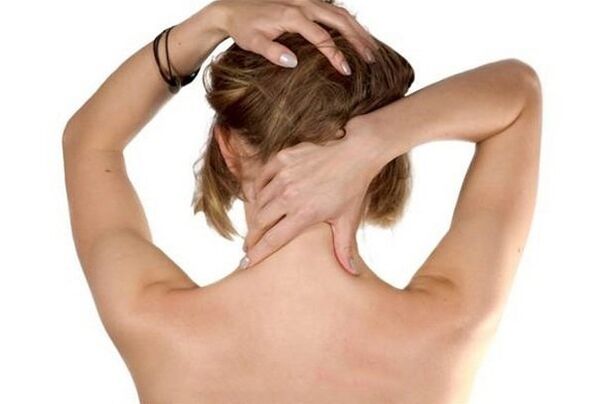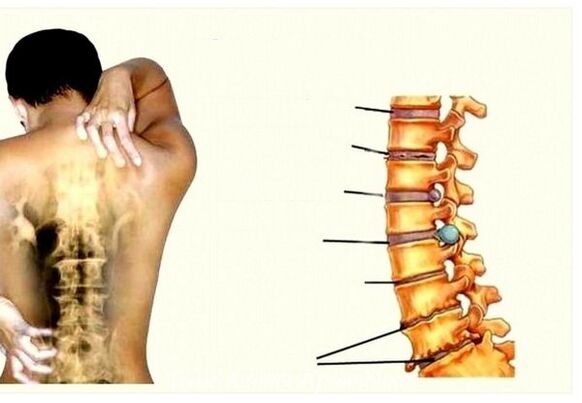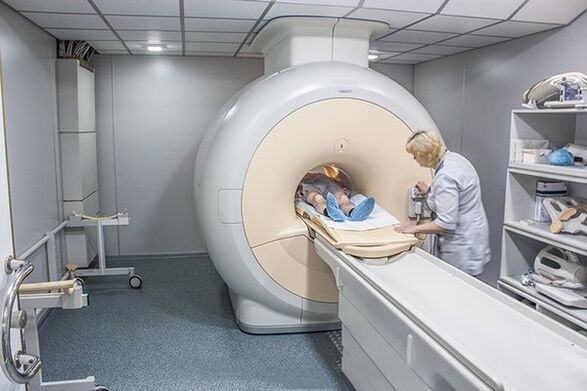
Hello, dear readers.Osteochondrosis is understood as a degenerative disease of the intervertebral cartilaginous layers.This problem has accepted global proportions today.In Europe alone, about 60% of adults suffer from cervical osteochondrosis.Doctors associate this fact with the staticity of people, their low mobility and a sedentary type of work.If not so long ago this disease has developed somewhere by the age of fifty, now it is impossible not to notice that the ailment has significantly rejuvenated-the average age threshold here has decreased to 24 years.But more and more often 18-year-old youth addresses this problem.Speaking about osteochondrosis of the cervical region, symptoms and treatment cannot be ignored, because these issues are of interest to many.
How osteochondrosis develops the cervical region - the causes and the first signs
Everyone knows that the spinal column is formed by bone vertebrae, between which the cartilaginous “pillows” are located - intervertebral discs.
Due to impaired blood flow and low-quality nutrition, cartilage tissue here does not receive a complex of nutrients.
This leads to a change in the structure of the cartilage, their deformation and shrinkage.They gradually lose their former elasticity, become less durable.
Since the shock -absorbing intervertebral layers dry out, the vertebrae eat on each other.As a result, the nerve endings and blood trunks are transmitted, which causes pain and numbness in the muscles, migraines and a number of other symptoms.

Over time, the cartilage is destroyed, turns into fibrous.Gradually, in this pathological process, adjacent vessels, nerve fibers, bone structures are involved.
The main factors of the development of cervical osteochondrosis
The fundamental cause of the development of osteochondrotic pathologies is considered to be degenerative-dystrophic changes.There are a number of factors that contribute to this.
Consider the main causes of osteochondrosis of the cervical spine.
- Congenital predisposition.
- The aging of the body.
- Criminations in metabolic processes.
- Excess weight, obesity.
- Errors in the diet are a lack of mineral compounds and systematic lack of fluid.
- Traumatic damage.
- The weakening of skeletal muscles, incorrect posture, flat feet.
- Hypodynamia, sedentary work.
- Physical overloads, the specifics of the profession, when you have to work in an uncomfortable position, make jerk -like muscle efforts, etc.
- The end of the sports career and the termination/reduction of power loads associated with this.
- Psycho-emotional overstrain.
- Nicotin dependence.
- The appearance of tumor structures.
It should be noted that the causes of pathological chondrotic changes in the cervical spine today are not sufficiently studied.
But it is reliably known that a long stay in a standing or sitting position without a special movement is excessively soft bed, untrained muscles of the back and belt of the upper extremities, inferior nutrition create an ideal combination for the development of cervical osteochondrosis.
Development of the disease
Osteochondrosis does not appear suddenly.It develops gradually for a rather long time - from several years to decades.
The initial dystrophic changes in the vertebrates do not give themselves out in any way.They can only be found by accident in an X -ray picture or during CT.

At the next stage of the development of the disease, a decrease in the thickness of the cartilage layer is observed.Microscopic cracks appear on intervertebral cartilage.Nun of individual muscles may appear.Over time, protrusion develops, hernias are possible.The patient is tormented by head and muscle pain.
At the last stage of the progression of the disease, bone tissue is pathologically grow, the nerve endings are damaged and chronic pain develops.Due to cervical osteochondrosis, curvature of the upper part of the spine, radiculitis, stenosis (narrowing of the lumen of the spinal canal) can be observed.
Osteochondrosis of the cervical region - symptoms and treatment
We examined the first signs of osteochondrosis, now we will talk, directly about the symptoms of cervical osteochondrosis.
Symptoms
For cervical osteochondrosis, the following symptoms are characteristic:
- Numbness and spasming of the muscles of the neck, shoulders and upper back.
- Pulling sensations, pain in the dorsal and cervicals.
- Pain can be given to their hands.
- Headaches, especially in the occipital region, migraines.
- Dizziness, ears in the ears, visual anomalies (defocusing, the appearance of "flies" and colored spots).
- Regular numbness of the fingers of the upper extremities.
- The stiffness of the movements of the head, the restriction of rotation and inclination, everything is accompanied by pain and pulling sensations.
- Soreness on palpation of the reciprocal zone.
- A tendency to increase pressure.
Due to muscle weakness, violations in coordination of movements can be observed.In the presence of cardiological problems, their aggravation is possible due to spasmings of the vertebral artery.The pain can spread to the area of the sternum and the rally.
As you can see, the symptoms are diverse.This leads to the fact that people, revealing certain deviations in themselves, turn to the help of this specialist (cardiologist, orthopedist, traumatologist).This complicates the diagnosis and timely detection of cervical osteochondrosis.
Which doctor should you contact with osteochondrosis
When a complex of described symptoms of osteochondrosis appears, you should seek medical help without delay.
You need to get an appointment with a therapist or a neurologist.After the initial clarification of the clinical picture as a result of a survey, examination of the patient and palpation of the affected area, the doctor will give a referral for tests and prescribe an additional examination.
You may need to go through:
- X -ray.
- Computer tomography.
- MRI.
- Electromyography.
X -ray will determine the place of localization of the lesions and the degree of neglect of the disease.A tomographic study will help to assess the condition of adjacent tissues, and myography is the conductivity of muscle fibers and their innervation.

All this will make it possible to make a diagnosis correctly and outline an effective treatment regimen.The process will be long, requiring patience and work on oneself.
It will not be possible to completely restore the cartilage structures, but to significantly improve the quality of life and get rid of chronic pains is a fulfilling task.
The examinations will have to return more than once.After all, it will be necessary to track the course of the disease, adjust the treatment program, predict possible complications or improvements.
Therefore, even if the pain has receded, this is not a reason to refuse to carry out repeated diagnostic measures.
How to deal with osteochondrosis of the neck
In order for the disease to release the disease, a whole set of various methods should be used.Active treatment in most cases takes several months.But here much depends on the enthusiasm, the good faith of the patient and his willpower.In some cases, surgical intervention is required.
When starting treatment, it is necessary to adhere to the following principles.
- Medical recommendations should be followed steadily.About all changes in the state and undesirable reactions should be informed of the attending physician.
- It is necessary to learn how to dose the load, avoid excessive muscle activity and muscular overstrain of the cervical region.
- It is necessary to abandon sports overloads, and if necessary, change the work.
- Medical and physical education classes are a prerequisite.They should be carried out systematically, and preferably daily.Special gymnastics for the neck should be selected individually, taking into account the possibilities of the patient and the degree of neglect of the disease.The set of exercises is performed under the guidance of an instructor.
- The use of anti -inflammatory and analgesic drugs should be justified and strictly dosed.All medicines, especially hormonal, are prescribed by a doctor.
- It is important to maintain an anatomically correct body position.Even in a dream.Therefore, the mattress should have sufficient rigidity.With an orthopedic pillow are determined by direct selection.
- If necessary, you should sit for a long time regularly, with an interval of a couple of hours, conduct a short warm -up for the neck.It is advisable to get up, although a sitting position is also allowed.
Why should warm up?
This simple way will allow:
- restore normal blood flow;
- knead the stiff muscles;
- get rid of numbness, tingling, pulling sensations;
- relieve muscular tension;
- prevent tossing muscles and their groups;
- Avoid overloading the cervical region.
All exercises are as simple as possible.They are familiar to everyone since childhood and do not take much time.A few minutes is enough.They can be performed both at home and at the workplace.
Breaking out of the views of tactless employees?Solve on the stairs or in the booth of the toilet.Perhaps you will even be able to inconspicuously do exercises in transport, avoiding unnecessary attention.
All exercises should be performed with a straightened back.It is recommended to expand the shoulders and sprinkle the chest somewhat.Make maximum permissible turns with your head to the sides.
Act neatly and without fanaticism so as not to harm a weakened spine.After that, several times alternately lower your head to one or the other shoulder.Now you can perform several rotational movements-10-15 in each side.
Another good exercise.Expand the spine up as much as possible, as if you were hung by the crown.Now slowly tilt your head forward, trying to press the edge of the chin to the chest.Then you need to slowly and very carefully perform the opposite action.
Attention!In the presence of some damage, you cannot reject your head back!Consult your doctor.
The procedure for performing exercises does not matter.A set of actions and the number of repetitions is selected individually.Wrapping your neck, do not forget about the thoracic region.They are closely connected.
It is recommended to try to bring the shoulder blades together from time to time.Perhaps you will hear a crunch.Do not be scared - these are the vertebrae in place.After that, as a rule, relief is felt.
To relieve tension in the trapezoidal muscle, raise the shoulders as much as possible as much as possible.Actions are performed several times.After that, shut your shoulders and shake your hands.
Medicines
For cervical osteochondrosis, several types of medications are used.These drugs are used during periods of exacerbation of the disease.
They are designed to solve a number of problems:
- elimination of pain;
- the fight against inflammation;
- Strengthening the metabolic processes in affected tissues.
Preparations, including hormonal and vitamin, are also used, which stimulate the restoration of cartilage.
Other methods of combating pain
In addition to exercise therapy and medicines, the set of measures to get rid of manifestations of osteochondrosis of the cervical zone includes the following methods of exposure.
- An increase in intervertebral spaces due to the elimination of the spinal column.For this, the dosed load is applicable.The impact is carried out in different ways, including using special tables.This measure allows the spine to return the previous length, give it the correct shape, and release the restless nerves.Some patients, desperate to find an effective way to get rid of chronic pains, turn to bone rights.Here the spine is subjected to aggressive effects.This method can help on condition that there will be a professional who has a medical education.
- Massage also gives good results.This procedure helps to disperse blood, improve the nutrition and gas exchange of cartilage, relieve tension and muscle clamps, and get rid of pain.If possible, you should resort to self -massage.But you need to act correctly, having passed the appropriate briefing.You can massage the neck, shoulders, scalp, arms, collar zone on your own.Rubbing, kneading, small pressure is used.Supreme massage is effective when exposure is made on active body points.But here we need special knowledge and considerable experience.Therefore, only a professional manual therapist should be addressed.
- Physiotherapeutic effect implies the use of various means: magnetic field, laser, ultrasound, low -frequency current, etc. Medicines are often used here.This method of introducing them has a local effect, enhances their effectiveness, and avoids a number of side effects.Physical Procedure help to fight pain, inflammation, accelerate post -traumatic and postoperative rehabilitation.
- The acupuncture, like manual therapy, enhances or inhibits various processes in the body due to the effects on the so -called biologically active points on the body.Reflexotherapy allows you to adjust the metabolism, enhance blood flow, and relieve pain.But despite its effectiveness, this method is not suitable for everyone, because it implies the use of needles, which some patients categorically do not accept.
The greatest efficiency of these measures is achieved when using them in a single complex under medical supervision.To a large extent, the success of therapy depends on the determination of the patient and his desire to cope with osteochondrosis.






















